功能肺与放射性肺损伤
- 格式:pdf
- 大小:359.08 KB
- 文档页数:6
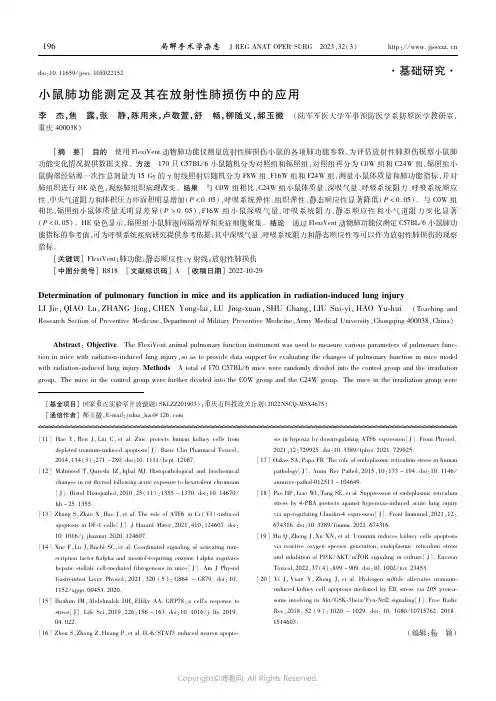
doi:10.11659/jjssx.10E022152·基础研究·小鼠肺功能测定及其在放射性肺损伤中的应用李 杰,焦 露,张 静,陈用来,卢敬萱,舒 畅,柳随义,郝玉徽 (陆军军医大学军事预防医学系防原医学教研室,重庆400038)[摘 要] 目的 使用FlexiVent动物肺功能仪测量放射性肺损伤小鼠的各项肺功能参数,为评估放射性肺损伤模型小鼠肺功能变化情况提供数据支撑。
方法 170只C57BL/6小鼠随机分为对照组和辐照组,对照组再分为C0W组和C24W组,辐照组小鼠胸部经钴源一次性总剂量为15Gy的γ射线照射后随机分为F8W组、F16W组和F24W组,测量小鼠体质量和肺功能指标,并对肺组织进行HE染色,观察肺组织病理改变。
结果 与C0W组相比,C24W组小鼠体质量、深吸气量、呼吸系统阻力、呼吸系统顺应性、中央气道阻力和体积压力环面积明显增加(P<0.05),呼吸系统弹性、组织弹性、静态顺应性显著降低(P<0.05)。
与C0W组相比,辐照组小鼠体质量无明显差异(P>0.05),F16W组小鼠深吸气量、呼吸系统阻力、静态顺应性和小气道阻力变化显著(P<0.05)。
HE染色显示,辐照组小鼠肺泡间隔增厚和炎症细胞聚集。
结论 通过FlexiVent动物肺功能仪测定C57BL/6小鼠肺功能指标的参考值,可为呼吸系统疾病研究提供参考依据;其中深吸气量、呼吸系统阻力和静态顺应性等可以作为放射性肺损伤的观察指标。
[关键词]FlexiVent;肺功能;静态顺应性;γ射线;放射性肺损伤[中图分类号]R818 [文献标识码]A [收稿日期]2022 10 29Determinationofpulmonaryfunctioninmiceanditsapplicationinradiation inducedlunginjuryLIJie,QIAOLu,ZHANGJing,CHENYong lai,LUJing xuan,SHUChang,LIUSui yi,HAOYu hui (TeachingandResearchSectionofPreventiveMedicine,DepartmentofMilitaryPreventiveMedicine,ArmyMedicalUniversity,Chongqing400038,China)Abstract:Objective TheFlexiVentanimalpulmonaryfunctioninstrumentwasusedtomeasurevariousparametersofpulmonaryfunc tioninmicewithradiation inducedlunginjury,soastoprovidedatasupportforevaluatingthechangesofpulmonaryfunctioninmicemodelwithradiation inducedlunginjury.Methods Atotalof170C57BL/6micewererandomlydividedintothecontrolgroupandtheirradiationgroup.ThemiceinthecontrolgroupwerefurtherdividedintotheC0WgroupandtheC24Wgroup.Themiceintheirradiationgroupwere [基金项目]国家重点实验室开放课题(SKLZZ201903);重庆市科技攻关计划(2022NSCQ MSX4675) [通信作者]郝玉徽,E mail:yuhui_hao@126.com[11]HaoY,RenJ,LiuC,etal.Zincprotectshumankidneycellsfromdepleteduranium inducedapoptosis[J].BasicClinPharmacolToxicol,2014,114(3):271-280.doi:10.1111/bcpt.12167.[12]MahmoodT,QureshiIZ,IqbalMJ.Histopathologicalandbiochemicalchangesinratthyroidfollowingacuteexposuretohexavalentchromium[J].HistolHistopathol,2010,25(11):1355-1370.doi:10.14670/hh-25.1355.[13]ZhangS,ZhaoX,HaoJ,etal.TheroleofATF6inCr(VI) inducedapoptosisinDF 1cells[J].JHazardMater,2021,410:124607.doi:10.1016/j.jhazmat.2020.124607.[14]XueF,LuJ,BuchlSC,etal.Coordinatedsignalingofactivatingtran scriptionfactor6alphaandinositol requiringenzyme1alpharegulateshepaticstellatecell mediatedfibrogenesisinmice[J].AmJPhysiolGastrointestLiverPhysiol,2021,320(5):G864-G879.doi:10.1152/ajpgi.00453.2020.[15]IbrahimIM,AbdelmalekDH,ElfikyAA.GRP78:acell sresponsetostress[J].LifeSci,2019,226:156-163.doi:10.1016/j.lfs.2019.04.022.[16]ZhouS,ZhongZ,HuangP,etal.IL 6/STAT3inducedneuronapoptosisinhypoxiabydownregulatingATF6expression[J].FrontPhysiol,2021,12:729925.doi:10.3389/fphys.2021.729925.[17]OakesSA,PapaFR.Theroleofendoplasmicreticulumstressinhumanpathology[J].AnnuRevPathol,2015,10:173-194.doi:10.1146/annurev pathol 012513-104649.[18]PaoHP,LiaoWI,TangSE,etal.Suppressionofendoplasmicreticulumstressby4 PBAprotectsagainsthyperoxia inducedacutelunginjuryviaup regulatingClaudin 4expression[J].FrontImmunol,2021,12:674316.doi:10.3389/fimmu.2021.674316.[19]HuQ,ZhengJ,XuXN,etal.Uraniuminduceskidneycellsapoptosisviareactiveoxygenspeciesgeneration,endoplasmicreticulumstressandinhibitionofPI3K/AKT/mTORsignalinginculture[J].EnvironToxicol,2022,37(4):899-909.doi:10.1002/tox.23453.[20]YiJ,YuanY,ZhengJ,etal.Hydrogensulfidealleviatesuranium inducedkidneycellapoptosismediatedbyERstressvia20Sprotea someinvolvinginAkt/GSK 3beta/Fyn Nrf2signaling[J].FreeRadicRes,2018,52(9):1020-1029.doi:10.1080/10715762.2018.1514603.(编辑:杨 颖)691局解手术学杂志 JREGANATOPERSURG 2023,32(3) http://www.jjssxzz.cnCopyright©博看网. All Rights Reserved.randomlydividedintotheF8Wgroup,theF16Wgroup,andtheF24Wgroupafterthechestwasirradiatedwithgammarayswithatotaldoseof15Gybycobaltsource.Thebodyweightandpulmonaryfunctionindexesofmiceweremeasured,andthelungtissuewasstainedwithHEstainingtoobservethepathologicalchangesoflungtissues.Results ComparedwiththeC0Wgroup,thebodyweight,inspiratorycapacity,respiratoryresistance,respiratorycompliance,centralairwayresistance,andpressure volumeloopareaintheC24Wgroupweresignificantlyincreased(P<0.05),whiletherespiratoryelasticity,tissueelasticityandstaticcomplianceweresignificantlydecreased(P<0.05).ComparedwiththeC0Wgroup,therewasnosignificantdifferenceinthebodyweightofmiceintheirradiationgroup(P>0.05),butthereweresignificantchangesintheinspiratorycapacity,respiratoryresistance,staticcomplianceandsmallairwayresistanceofmiceintheF16Wgroup(P<0.05).HEstainingshowedthatthealveolarseptaoftheirradiationgroupthickenedandgatheredtheinflammatorycells.Conclusion ThereferencevaluesofpulmonaryfunctionindexesofC57BL/6micemeasuredbyFlexiVentanimalpulmonaryfunctioninstru mentcanprovideareferencebasisforthestudyofrespiratorydiseases;amongthem,theinspiratorycapacity,respiratoryresistanceandstaticcompliancecanbeusedastheobservationindicatorsofradiation inducedlunginjury.Keywords:FlexiVent;pulmonaryfunction;staticcompliance;gammaray;radiation inducedlunginjury 肺功能检查是临床上常见的检查,常用于健康人群体检和呼吸系统疾病检查,在呼吸系统疾病的早期筛查和诊断中具有重要作用[1 2]。
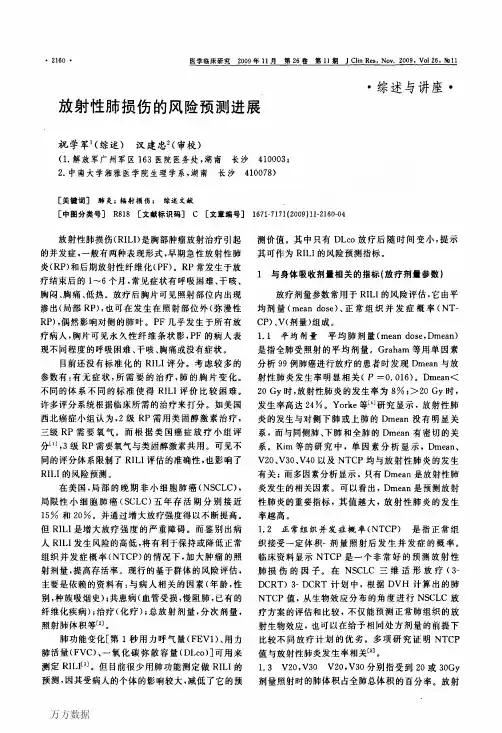
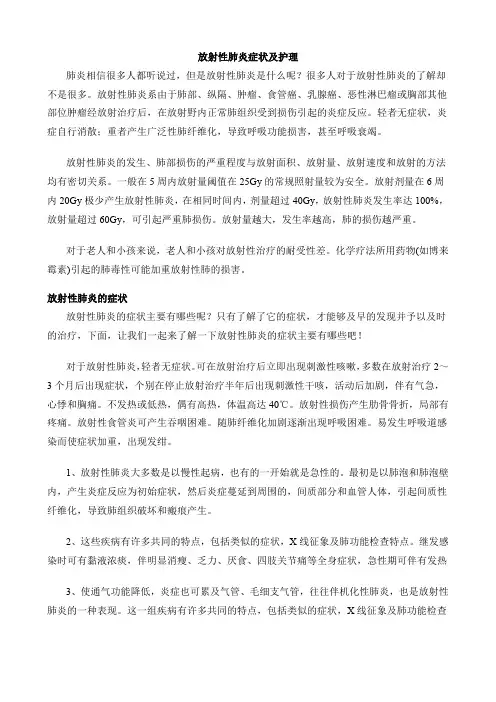
放射性肺炎症状及护理肺炎相信很多人都听说过,但是放射性肺炎是什么呢?很多人对于放射性肺炎的了解却不是很多。
放射性肺炎系由于肺部、纵隔、肿瘤、食管癌、乳腺癌、恶性淋巴瘤或胸部其他部位肿瘤经放射治疗后,在放射野内正常肺组织受到损伤引起的炎症反应。
轻者无症状,炎症自行消散;重者产生广泛性肺纤维化,导致呼吸功能损害,甚至呼吸衰竭。
放射性肺炎的发生、肺部损伤的严重程度与放射面积、放射量、放射速度和放射的方法均有密切关系。
一般在5周内放射量阈值在25Gy的常规照射量较为安全。
放射剂量在6周内20Gy极少产生放射性肺炎,在相同时间内,剂量超过40Gy,放射性肺炎发生率达100%,放射量超过60Gy,可引起严重肺损伤。
放射量越大,发生率越高,肺的损伤越严重。
对于老人和小孩来说,老人和小孩对放射性治疗的耐受性差。
化学疗法所用药物(如博来霉素)引起的肺毒性可能加重放射性肺的损害。
放射性肺炎的症状放射性肺炎的症状主要有哪些呢?只有了解了它的症状,才能够及早的发现并予以及时的治疗,下面,让我们一起来了解一下放射性肺炎的症状主要有哪些吧!对于放射性肺炎,轻者无症状。
可在放射治疗后立即出现刺激性咳嗽,多数在放射治疗2~3个月后出现症状,个别在停止放射治疗半年后出现刺激性干咳,活动后加剧,伴有气急,心悸和胸痛。
不发热或低热,偶有高热,体温高达40℃。
放射性损伤产生肋骨骨折,局部有疼痛。
放射性食管炎可产生吞咽困难。
随肺纤维化加剧逐渐出现呼吸困难。
易发生呼吸道感染而使症状加重,出现发绀。
1、放射性肺炎大多数是以慢性起病,也有的一开始就是急性的。
最初是以肺泡和肺泡壁内,产生炎症反应为初始症状,然后炎症蔓延到周围的,间质部分和血管人体,引起间质性纤维化,导致肺组织破坏和瘢痕产生。
2、这些疾病有许多共同的特点,包括类似的症状,X线征象及肺功能检查特点。
继发感染时可有黏液浓痰,伴明显消瘦、乏力、厌食、四肢关节痛等全身症状,急性期可伴有发热3、使通气功能降低,炎症也可累及气管、毛细支气管,往往伴机化性肺炎,也是放射性肺炎的一种表现。
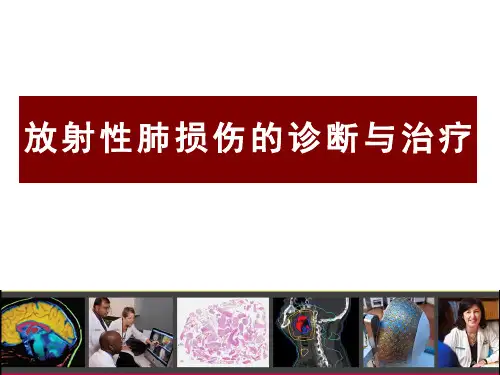

干细胞移植相关的伴随症状与并发症介绍干细胞移植是一项先进的医疗技术,可用于治疗多种疾病,包括白血病、淋巴瘤、多发性骨髓瘤等。
然而,干细胞移植也会伴随一些症状和并发症,因此在进行这项治疗时,患者和医护人员需要对其有所了解。
本篇文章将介绍干细胞移植相关的伴随症状与并发症,以帮助读者更加全面地了解这一治疗过程。
干细胞移植的伴随症状主要包括:1. 骨髓抑制: 干细胞移植过程中,患者会接受强化化疗和放疗来准备骨髓的移植。
这些治疗会导致骨髓抑制,使血液中产生血细胞的能力下降。
患者可能会出现贫血、白细胞减少和血小板减少等症状,如疲劳、易出血和感染等。
2. 消化道症状: 干细胞移植后,患者可能出现消化道症状,如恶心、呕吐、腹泻和口腔溃疡等。
这些症状主要是由于化疗药物对胃肠道黏膜的损伤所致。
3. 皮肤反应: 干细胞移植会导致皮肤过敏反应和皮肤损伤。
患者可能会出现皮疹、瘙痒、干燥、脱屑和色素沉着等症状。
4. 肝脏和肾脏功能异常: 干细胞移植后,患者的肝脏和肾脏功能可能会受到影响。
他们可能会出现黄疸、肝功能异常和尿频等症状。
这些症状往往是由化疗药物的毒副作用引起的。
5. 免疫系统异常: 干细胞移植会导致患者的免疫系统受损,使其容易感染病菌。
患者可能会出现反复发热、感染性病变和呼吸系统症状等。
干细胞移植的并发症主要包括:1. 移植物排斥反应: 在干细胞移植过程中,患者的免疫系统可能会对移植物产生排斥反应。
这可能导致移植物无法存活和成功植入,最终影响治疗效果。
2. 移植物抗宿主病: 移植物抗宿主病是干细胞移植治疗中较为严重的并发症之一。
它是由移植物中的免疫细胞攻击患者的组织和器官引起的。
患者可能会出现皮肤疹、黄疸、腹泻和肝脾肿大等症状。
3. 放射性肺损伤: 干细胞移植前,患者通常会接受全身或局部放疗治疗,以准备骨髓的移植。
这可能会导致患者出现放射性肺损伤,表现为气短、咳嗽和呼吸困难等症状。
4. 心血管系统并发症: 干细胞移植后,患者可能会出现心血管系统并发症,如心律失常、心肌损伤和心力衰竭等。



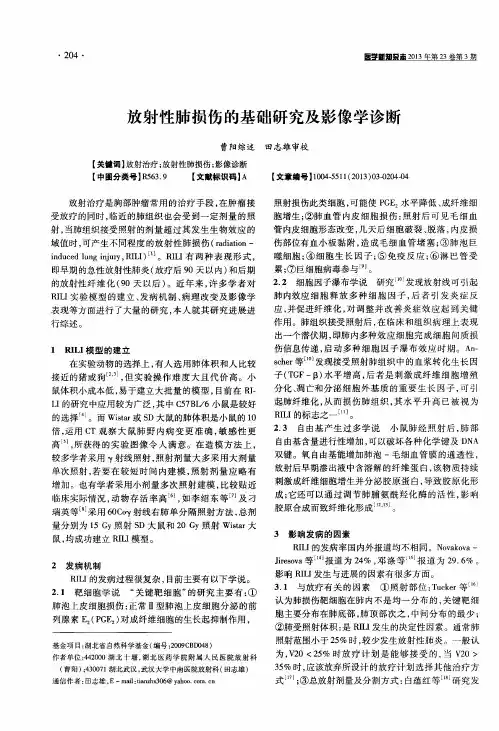
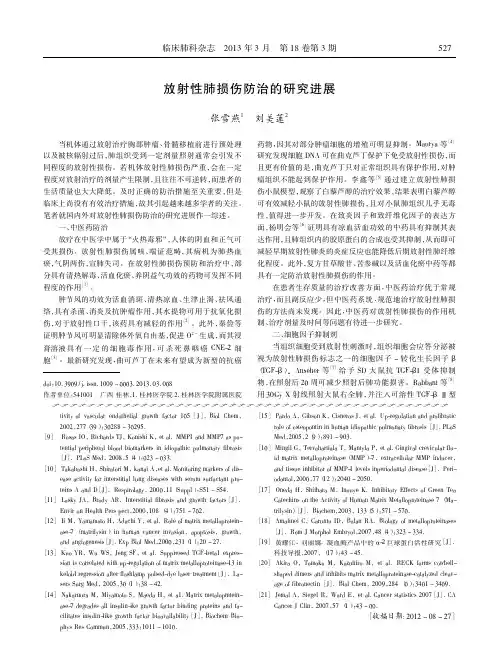
檸檸檸檸檸檸檸檸檸檸檸檸檸檸檸檸檸檸檸檸檸檸檸檸檸檸檸檸檸檸檸檸檸檸檸檸檸檸檸檸檸檸檸檸檸tivity of vascular endothelial growth factor165[J].Biol Chem,2002,277(39):36288-36295.[9]Rosas IO,Richards TJ,Konishi K,et al.MMP1and MMP7as po-tential peripheral blood biomarkers in idiopathic pulmonary fibrosis [J].PLoS Med,2008,5(4):623-633.[10]Takahashi H,Shiratori M,kanai A,et al.Monitoring markers of dis-ease activity for interstitial lung diseases with serum surfactant pro-teins A and D[J].Respirology,2006,11(Suppl):S51-S54.[11]Lasky JA,Brody AR.Interstitial fibrosis and growth factors[J].Envir on Health Pers pect,2000,108(4):751-762.[12]Ii M,Yamamoto H,Adachi Y,et al.Role of matrix metalloprotein-ase-7(matrilysin)in human cancer invasion,apoptosis,growth,and angiogenesis[J].Exp Biol Med,2006,231(1):20-27.[13]Kuo YR,Wu WS,Jeng SF,et al.Suppressed TGF-beta1expres-sion is correlated with up-regulation of matrix metalloproteinase-13inkeloid regression after flashlamp pulsed-dye laser treatment[J].La-sers Surg Med,2005,36(1):38-42.[14]Nakarnura M,Miyamoto S,Maeda H,et a1.Matrix metalopmtein-ase-7degrades all insulin-ike growth factor binding proteins and fa-cilitates insulin-like growth factor bioavailability[J].Biochem Bio-phys Res Commun,2005,333:1011-1016.[15]Pardo A,Gibson K,Cisneros J,et al.Up-regulation and profibrotic role of osteopontin in human idiopathic pulmonary fibrosis[J].PLoSMed,2005,2(9):891-903.[16]Mingil G,Tervahartiala T,Mantyla P,et al.Gingival crevicular flu-id matrix metalloproteinase(MMP)-7,extracellular MMP inducer,and tissue inhibitor of MMP-1levels inperiodontal disease[J].Peri-odontol,2006,77(12):2040-2050.[17]Oneda H,Shiihara M,Inouye K.Inhibitory Effects of Green Tea Catechins on the Activity of Human Matrix Metalloproteinase7(Ma-trilysin)[J].Biochem,2003,133(5):571-576.[18]Amalinei C,Caruntu ID,Balan RA.Biology of metalloproteinases [J].Rom J Morphol Embryol,2007,48(4):323-334.[19]黄耀江,刘丽娜.凝血酶产品中的α-2巨球蛋白活性研究[J].科技导报,2007,(17):43-45.[20]Akira O,Tomoko M,Kazuhiro M,et al.RECK forms cowbell-shaped dimers and inhibits matrix metalloproteinase-catalyzed cleav-age of fibronectin[J].Biol Chem,2009,284(6):3461-3469.[21]Jemal A,Siegel R,Ward E,et al.Cancer statistics2007[J].CA Cancer J Clin,2007,57(1):43-66.[收稿日期:2012-08-27]放射性肺损伤防治的研究进展张雪燕1刘美莲2当机体通过放射治疗胸部肿瘤、骨髓移植前进行预处理以及被核辐射过后,肺组织受到一定剂量照射通常会引发不同程度的放射性损伤。
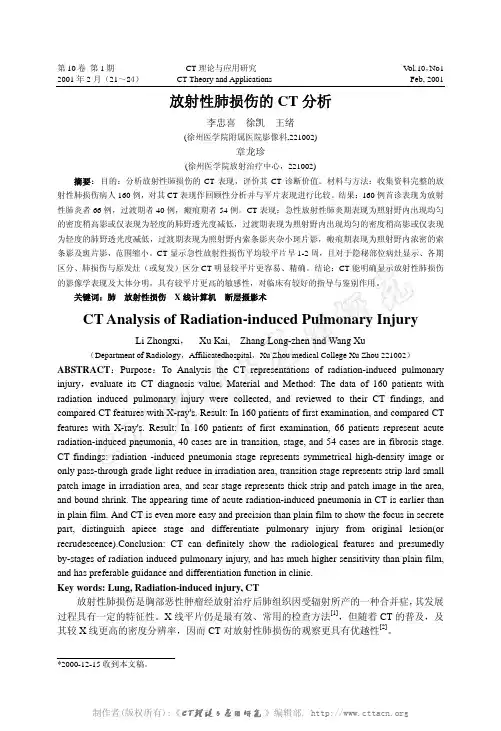
第10卷第1期CT理论与应用研究V ol.10,No1 2001年2月(21~24) CT Theory and Applications Feb, 2001*2000-12-15收到本文稿。
放射性肺损伤的CT分析李忠喜徐凯王绪(徐州医学院附属医院影像科,221002)章龙珍(徐州医学院放射治疗中心,221002)摘要:目的:分析放射性肺损伤的CT表现,评价其CT诊断价值。
材料与方法:收集资料完整的放射性肺损伤病人160例,对其CT表现作回顾性分析并与平片表现进行比较。
结果:160例首诊表现为放射性肺炎者66例,过渡期者40例,瘢痕期者54例。
CT表现:急性放射性肺炎期表现为照射野内出现均匀的密度稍高影或仅表现为轻度的肺野透光度减低,过渡期表现为照射野内出现均匀的密度稍高影或仅表现为轻度的肺野透光度减低,过渡期表现为照射野内索条影夹杂小斑片影,瘢痕期表现为照射野内浓密的索条影及斑片影,范围缩小。
CT显示急性放射性损伤平均较平片早1-2周,且对于隐秘部位病灶显示、各期区分、肺损伤与原发灶(或复发)区分CT明显较平片更容易、精确。
结论:CT能明确显示放射性肺损伤的影像学表现及大体分明,具有较平片更高的敏感性,对临床有较好的指导与鉴别作用。
关键词:肺放射性损伤X线计算机断层摄影术CT Analysis of Radiation-induced Pulmonary InjuryLi Zhongxi, Xu Kai, Zhang Long-zhen and Wang Xu(Department of Radiology,Affilicatedhospital,Xu Zhou medical College Xu Zhou 221002)ABSTRACT:Purpose:To Analysis the CT representations of radiation-induced pulmonary injury,evaluate its CT diagnosis value. Material and Method: The data of 160 patients with radiation induced pulmonary injury were collected, and reviewed to their CT findings, and compared CT features with X-ray's. Result: In 160 patients of first examination, and compared CT features with X-ray's. Result: In 160 patients of first examination, 66 patients represent acute radiation-induced pneumonia, 40 cases are in transition, stage, and 54 cases are in fibrosis stage. CT findings: radiation -induced pneumonia stage represents symmetrical high-density image or only pass-through grade light reduce in irradiation area, transition stage represents strip lard small patch image in irradiation area, and scar stage represents thick strip and patch image in the area, and bound shrink. The appearing time of acute radiation-induced pneumonia in CT is earlier than in plain film. And CT is even more easy and precision than plain film to show the focus in secrete part, distinguish apiece stage and differentiate pulmonary injury from original lesion(or recrudescence).Conclusion: CT can definitely show the radiological features and presumedly by-stages of radiation induced pulmonary injury, and has much higher sensitivity than plain film, and has preferable guidance and differentiation function in clinic.Key words: Lung, Radiation-induced injury, CT放射性肺损伤是胸部恶性肿瘤经放射治疗后肺组织因受辐射所产的一种合并症,其发展过程具有一定的特征性。
放射损伤的临床疾病摘要:长期、大量、不当的应用放射性物质会对人体造成放射性损伤。
放射性疾病可分为外照射性放射病和内照射性放射病。
外照射性放射病又可分为外照射急性放射病、外照射亚急性放射病、外照射慢性放射病。
放射损伤可引起呼吸、消化、泌尿、中枢、血液系统及皮肤、口腔、心脏、眼睛、甲状腺和子代遗传等发生不同程度的病变。
关键词:放射诊断临床疾病19世纪末,随着X射线和天然放射性物质的相继发现,电离辐射源和放射性物质在人类生产和生活实践中不断地得到广泛的应用,促进了人类社会的发展。
而长期、大量乃至不当的应用电离辐射源和放射性物质会对人体造成放射性损伤,严重地威胁着人们的健康。
一、放射性疾病的分类1.外照射急性放射病外照射急性放射病是体内一次或短时间(数日)内分次受到大剂量体外电离辐射而引起的全身性疾病。
该辐射可由X射线、γ射线或中子等引起。
其原因有核泄漏事故,医疗工作中X、γ射线应用于肿瘤,器官移植的起剂量照射。
临床以骨髓造血功能障碍损为主,表现为继发感染、出血和全血细胞下降三大特征;有些人表现为呕吐、腹泻、脱发、拒食、衰竭以至死亡。
2.外照射亚急性放射病7 人体在较长时间内(数周至数月)连续或间断遭受到较大剂量外照射,其累积剂量大于1.0Gy,照射量率小于急性放射病而明显大于慢性放射病,并以造血功能再生障碍为主的全身性疾病称外照射亚急性放射病。
其临床特点为起病缓慢、造血功能障碍、外周血淋巴细胞染色体畸变率明显增高、明显的微循环变化、免疫功能及生殖功能低下,凝血机制障碍。
3.外照射慢性放射病外照射慢性放射病是指放射工作人员在较长时间内连续或间断受到超剂量当量限值的外照射,累积剂量超过1.5Sv以上引起的以造血组织损伤为主并伴有其他系统改变的全身性疾病。
慢性放射源外照射主要来源于选矿、冶炼、探伤、放射源制备、土壤成份测量、贮藏、医学治疗以及核物理试验和研究等行业。
神经、造血、内分泌、免疫等系统功能障碍、晶状体病变等是其临床主要特征。
摘要:肺鳞癌是肺癌中最常见的类型之一,治疗肺鳞癌的方法主要包括手术、放疗、化疗和靶向治疗等。
然而,这些治疗方法在治愈疾病的同时,也可能带来一系列的风险和副作用。
本文将对肺鳞癌治疗方案的风险进行详细分析,以期为临床治疗提供参考。
一、手术风险1. 手术风险(1)麻醉风险:麻醉过程中可能出现呼吸抑制、血压下降、心率失常等并发症。
(2)术中出血:手术过程中可能出现血管破裂,导致出血过多。
(3)术后感染:术后伤口感染、肺部感染等。
(4)肺功能损害:肺叶切除或肺段切除后,患者肺功能可能受到影响。
(5)呼吸功能不全:术后可能因呼吸肌无力、呼吸道分泌物增多等原因导致呼吸功能不全。
2. 手术并发症(1)肺栓塞:术后长时间卧床可能导致肺栓塞。
(2)支气管胸膜瘘:手术过程中可能损伤支气管,导致支气管胸膜瘘。
(3)肺不张:术后肺部可能因痰液堵塞、肺叶切除等原因导致肺不张。
二、放疗风险1. 放疗风险(1)放射性肺炎:放疗过程中可能损伤肺部组织,导致放射性肺炎。
(2)放射性食管炎:放疗过程中可能损伤食管,导致放射性食管炎。
(3)放射性皮肤反应:放疗过程中可能损伤皮肤,导致皮肤反应。
(4)放射性脑损伤:放疗过程中可能损伤脑组织,导致放射性脑损伤。
2. 放疗并发症(1)放射性肺纤维化:放疗后可能引起肺纤维化,影响肺功能。
(2)放射性心脏损伤:放疗后可能引起心脏损伤,影响心脏功能。
(3)放射性肠炎:放疗后可能引起肠炎,影响肠道功能。
三、化疗风险1. 化疗风险(1)骨髓抑制:化疗药物可能抑制骨髓造血功能,导致白细胞、红细胞、血小板减少。
(2)恶心、呕吐:化疗药物可能引起恶心、呕吐等胃肠道反应。
(3)口腔黏膜炎:化疗药物可能引起口腔黏膜炎。
(4)脱发:化疗药物可能引起脱发。
2. 化疗并发症(1)感染:骨髓抑制可能导致患者免疫力下降,易发生感染。
(2)肝肾功能损害:化疗药物可能损害肝肾功能。
(3)心脏毒性:某些化疗药物可能引起心脏毒性。
肺功能分级标准
肺功能的五级分级法,是根据肺功能受损的严重程进行分级,具体如下:
1、1级:肺活量以及最大通气量在80%以上,残气量与肺总量的比值低于25%,肺功能基本处于正常状态,可像健康者一样活动。
2、2级:肺活量会有所减退,一般是在65%~79%之间,最大通气量在70%~79%之间,残气量与肺总量的比值在26%~30%之间,肺功能轻度受损。
在平地走路时可无任何症状,但爬楼梯时呼吸不顺畅。
3、3级:患者肺功能中度受损,肺活量显著减退,在50%~64%之间,最大通气量处于55%~69%之间,残气量与肺总量的比值达到了36%~45%。
可以在平地上缓慢行走,如果行走速度加快或者行走时间过长,容易出现呼吸困难。
4、4级:肺活量为35%~49%,肺功能重度受损,最大通气量只有40%~54%,残气量和肺总量的比值位于46%~55%之间。
走路速度明显减慢,短时间行走就会出现气急、呼吸困难的表现,通常无法继续行走。
5、5级:肺功能极重度受损,肺活量在32%以下,最大通气量在20%~39%之间,残气量和肺总量的比值高于55%。
即使在静息状态下,也容易出现气急、呼吸困难,正常活动严重受限。
如果出现3级以及以上的肺功能障碍,应及时到医院呼吸内科就诊,进行规范治疗。
平时注意劳逸结合,避免做剧烈运动,保持房间内通风良好。
EXPERIMENTAL AND THERAPEUTIC MEDICINE 2: 1017-1022, 2011Abstract. The aim of this study was to determine whether functional dose-volume histograms (FDVHs) are valuable for predicting radiation pneumonitis (RP), and to identify whether FDVHs have advantages over conventional dose-volume histograms (DVHs) for the prediction of RP in patients with locally advanced non-small cell lung cancer (LANSCLC). Fifty-seven patients with LANSCLC undergoing functional image-guided late-course accelerated hyperfractionated radiotherapy were enrolled. The grade of RP was evaluated according to the Common Toxicity Criteria 3.0. To identify predictive factors of RP, the FDVHs, including the volume of the functional lung receiving 5 Gy (FV5) through 50 Gy (FV50), mean perfusion-weighted lung dose (MPWLD) and functional normal tissue complication probability (FNTCP), were analyzed and compared to their counterparts [total lung receiving 5 Gy (V5) through 50 Gy (V50), mean lung dose (MLD) and normal tissue complication probability (NTCP)] derived from conventional DVHs. Univariate analysis revealed that V5-V40, MLD, NTCP and FV5-FV50, MPWLD, FNTCP were all statistically significant relative to the development of RP (all p<0.05). Multivariate analysis showed that only MLD and FV15 were associated with RP (p=0.001 and 0.044, respectively). Receiver operator characteristic curve anaysis indicated that almost all of the FDVHs had larger areas under the curve compared to the DVHs, although no statistically significant difference was observed (p-value ranged from 0.066 to 0.951). FDVHs are valuable for predicting RP with the predictive efficiency equivalent to or slightly advanta-geous over conventional DVHs. More homogeneous studies involving larger numbers of patients are required to further assess the value of FDVHs for predicting RP. IntroductionPlatinum-based chemoradiotherapy represents the current treat-ment standard for locally advanced non-small cell lung cancer (LANSCLC). However, treatment success is constrained by poor local control and radiation pneumonitis (RP). According to a systematic review (1), clinically significant RP usually develops in 13-37% of patients receiving radical dose radiation therapy for lung cancer. Despite the large number of studies (2-8,23,24) involving clinical and dosimetric prognostic factors for RP, there are currently no validated and standardized factors for prediction. In clinical practice, the mean lung dose (MLD) and VDth (the volume of lung receiving more than a threshold dose) are the most common parameters used as predictors (2-7). However, these parameters are not ideal due to their limited accuracy, sensitivity and specificity (1). This may be explained by the fact that radiation ideally should be delivered in a manner that minimizes its functional consequences (9). For the most part, this goal has been sought by trying to mini-mize the volume of computed tomography-defined lung tissue within the treatment fields. This approach does not, however, consider possible variations in the functional competence of different regions of the lung. The same problem arises in the interpretation of dose-volume histograms (DVHs) and calcula-tions of normal tissue complication probability (NTCP). From the viewpoint of biophysics, these parameters are constructed to consider both lungs as a homogeneous organ, however, conventional models do not take the possible spatial differences of lung radiosensitivity into account (10,11,27). Furthermore, co-existent lung diseases in the majority of patients presenting with lung cancer result in regional differences in lung function. Nioutsikou et al (12) considered that the functional heteroge-Functional dose-volume histograms for predicting radiation pneumonitis in locally advanced non-small cell lung cancer treated with late-course accelerated hyperfractionated radiotherapyDONGQING WANG1,2, BAOSHENG LI1, ZHONGTANG WANG1,JIAN ZHU3, HONGFU SUN1, JIAN ZHANG1 and YONG YIN31Sixth Department of Radiation Oncology, Shandong Cancer Hospital; 2Shandong Academy of Medical Sciences;3Department of Radiotherapy Physics, Shandong Cancer Hospital, Jinan, P.R. ChinaReceived March 10, 2011; Accepted June 23, 2011DOI: 10.3892/etm.2011.301Correspondence to: Dr Baosheng Li, Sixth Department of RadiationOncology, Shandong Cancer Hospital, Jiyan Road 440, Jinan,P.R. ChinaE-mail: baoshli@Abbreviations: FDVHs, functional dose-volume histograms;MPWLD, mean perfusion-weighted lung dose; FNTCP, functionalnormal tissue compilation probability; RP, radiation pneumonitis;LANSCLC, locally advanced non-small cell lung cancer; FL,functional lungKey words: non-small cell lung cancer, radiation pneumonitis,functional dose-volume histogramWANG et al: FUNCTIONAL DOSE-VOLUME HISTOGRAMS FOR PREDICTING RADIATION PNEUMONITIS 1018neity of an organ as a factor contributes to the probability ofcomplications in the normal tissues following radiotherapy.Using the functional dose-volume histograms (FDVHs) and thefunctional normal tissue complication probability (FNTCP)may be more meaningful for plan evaluation and is anticipatedto show a better correlation with RP.Materials and methodsPatient characteristics. Fifty-seven patients with stage IIINSCLC enrolled in a prospective phase II study from March2006 to April 2010 were analyzed. Eligibility criteria includedbiopsy-proven NSCLC, no prior chemotherapy or radio-therapy, no concurrent malignancy and no past history of lungcancer. The protocol was approved by the IRB, and informedconsent was obtained from all patients. All patients receivedlate-course accelerated hyperfractionated radiotherapy(LCAHRT) with three dimensional conformal (3D-CRT) orintensity-modulated radiotherapy (IMRT) techniques. Theinitial volume was treated with conventional fractionation to atotal dose of 40 Gy in 2-Gy fractions over 4 weeks; the boostvolume was irradiated with LCAHRT to additional doses of19.6-39.2 Gy in 2 fractions of 1.4 Gy with an interval of 6-8 hper day, 5 days per week over 2-3 weeks. Fifty (88%) patientsreceived 2-4 cycles of concurrent or sequential chemotherapywith cisplatin-based regimens. Seventy-nine percent of patientshad a history of smoking. The median baseline forced expira-tory volume in 1 sec (FEV1.0) was 2.08 liters (range 0.62-3.59).Patient characteristics are shown in Table I.Treatment planning and delivery. All patients were scannedusing a dedicated positron emission tomography/computedtomograpy (PET/CT; 4 slice Discovery LS; GE) simulator inthe supine position with arms extended above the head andimmobilized by a vacuum cradle device to improve the setupreproducibility during planning and delivery of treatmentaccording to the 18F-fluorodeoxyglucose (18F-FDG) PET/CTimaging protocol (13).Single photon emission computed tomography (SPECT;GE Infinia) scans were also performed in the treatment posi-tion on the next day, following injection of technetium-99m (99m Tc) labeled with macro-aggregated albumin (MAA) tracer. SPECT image acquisition and reconstruction were performed as previously described (9,10,20). After the required SPECT lung perfusion imaging, these functional images were all transferred to a Philips Pinnacle3 planning system (Philips Radiation Oncology Systems, Milpitas, CA, USA), and then registered manually with the aid of fiducial markers (12,14). The 18F-FDG PET/CT image was used to delineate the gross tumor volume (GTV), including the primary disease plus any involved regional lymph nodes as determined by size on the CT scan to be ≥1 cm or FDG-avid tumor and lymph nodes, regardless of their anatomic size. Before commencing the visual contouring, a diagnostically adequate window for image display was adjusted with the assistance of our nuclear medicine physician. The planning target volume (PTV) was considered to include the GTV plus a 10- to 15-mm margin. Ninety-five percent isodose line encompassed the PTV. Normal tissues (esophagus, spinal cord, heart and total lung) were contoured as usual. In particular, functional lung (FL) was weighted by 99m Tc-MAA SPECT lung perfusion. According to the study of Seppenwoolde et al (15), ≥30% of the maximum pre-RT perfusion was defined as ‘well-perfused’. It is assumed that perfusion is proportional to function (16,17). We delineated the regional well-perfused lung contours as FL. Based on the functional information, PET/CT/SPECT-guided radiotherapy planning was optimized (14,18).For 3D-CRT, four or five beams were consistently employed in the treatment plans, typically anterior-posterior beams in combination with oblique beams. In IMRT plans, five to seven beam angles were usually employed for dose optimization. Dose calculations were performed using Pinnacle3 version 7.6c (ADAC, Milpitas, CA, USA) with tissue heterogeneity correction. Planning objective for organs at risk was defined as follows: total lung receiving >20 Gy (V20) limited to ≤37%; maximum dose of spinal cord limited to ≤45 Gy; for heart, with constraints: D1/3 ≤50 Gy, D2/3 ≤45 Gy, D3/3 ≤40 Gy (D x is dose received by x of the volume). The treatment plans were reviewed by peers and Table I. Patient characteristics.Characteristic No. of patients(ratio and %) GenderMale:female 48 (84):9 (16) Age (years)≥60:<60 36 (63):21 (37) Histopathology, n (%)Squamous cell carcinoma 28 (49) Adenocarcinoma 20 (35) Large cell carcinoma 3 (5) NSCLC, not otherwise specified 6 (11) Clinical stageIIIA:IIIB 19 (33):38 (67) Karnofsky performance status≥80:<80 54 (95):3 (5) Smoking historyNo:yes 12 (21):45 (79) ChemotherapyConcurrent:sequential 34 (60):16 (28)Table II. Association of baseline characteristics with grade ≥2 radiation pneumonitis (RP).Characteristic No-RP RP p-value a(mean ± 1 SD)FEV1.0 (liters) 2.2±0.7 1.7±0.6 0.06 FVC (liters) 3.0±0.8 2.5±0.9 0.08 FEV1.0/FVC (%) 71.5±12.3 72.0±12.8 0.90 FEV1.0, forced expiratory volume in 1 sec; FVC, forced vital capacity.a Analyzed by independent-sample t-test.EXPERIMENTAL AND THERAPEUTIC MEDICINE 2: 1017-1022, 20111019delivered using 6 MV beams on linear accelerators (21EX, 23EX or Trilogy; Varian Inc., CA, USA).Functional dose-volumetric parametersFDVHs and mean perfusion-weighted lung dose (MPWLD). After a SPECT scan was adequately registered with the PET/ CT dataset, the entire 3D-RT dose distribution was overlaid onto the SPECT scan. The traditional DVHs of the total lung volume defined by CT were converted into new histograms, which were termed FDVHs (9,12,19,20). Based on these homogeneous functional sub-units, FDVHs were calculated from FV5 to FV50; meanwhile, conventional parameters V5-V50 were also calculated. The MLD was defined as the average dose throughout the total lung volume minus the GTV. Subsequently, the MLD was weighted with the local perfu-sion resulting in the MPWLD (10,20,26). The adjustment of the dose to the biologically equivalent dose by conventional fractionation size at 2 Gy was not carried out. Functional normal tissue complication probability. The Lyman model was used to calculate the NTCP from the DVHs. Assumptions used in the calculation were: n=0.87; m=0.18; TD50=24.5 Gy (21). The FNTCP was calculated from the FDVHs with the same n, m and TD50 values, and was used as an additional parameter.Evaluation of RP and follow-up. After completion of treat-ment, patients were followed up at 3-month intervals until RP was observed or the patients died. In our study, follow-up time ranged from 3 to 42 months, with follow-up for living patients determined to be a median of 14 months. In our analysis, the RP grade was defined according to the National Cancer Institute Common Toxicity Criteria, version 3.0 (22). The development of RP was considered as a binary variable: no-RP (RP grade ≤1) and RP (RP grade ≥2).Statistical analysis. The Chi-square test was applied to test patient characteristic distribution between the no-RP and RP groups. Univariate and multivariate analyses were used to evaluate the impact of DVHs and FDVHs on the develop-ment of RP. For the multivariate analysis, backward stepwise logistic regression analysis was adopted. Receiver operator characteristic (ROC) curves were used to identify the refer-ence threshold of FDVHs and to assess the predictability of the parameters. The correlation between the FDVHs and DVHs was tested by calculating the Pearson correlation coefficient. All statistical tests were two-tailed and were performed using statistical software programs Medcalc V.11.2 and SPSS V.11.5.A p-value of <0.05 was considered significant.ResultsClinical parameters. In the present study, 36 (63%) patients did not develop RP, 10 (18%) patients developed grade 1, 7 (12%) grade 2, 3 (5%) grade 3 and 1 grade 5 RP. The actuarial development of grade 2 or worse RP was 19.3%. There was no significant difference in the distribution of clinical parameters (gender, age, Karnofsky performance status, smoking history and chemotherapy) between the two groups of patients (no-RP vs. RP). FEV1.0 and forced vital capacity (FVC) investigated at borderline exhibited significance (p=0.06 and 0.08, respec-tively), where FEV1.0/FVC did not (p=0.90) (Table II).Dose-volumetric parameters. Tables III and IV summarize the analysis of the potential predictors of DVHs to RP. V5-V40, MLD and NTCP were statistically significant, whereas multi-variate analysis showed that MLD was the only risk factor (p=0.001).Tables III and V summarize the analysis of the potential predictors of FDVHs to RP. FV5-FV50, MPWLD and FNTCP were all statistically significant, whereas multivariate logistic regression analysis showed that FV15 was the most important risk factor (p=0.044).Table VI reports the sensitivity and specificity of FDVHs for RP prediction. Using ROC curve analysis, all of the FDVHs, with the exception of MPWLD, had larger AUCs than their counterparts from DVHs, although no significant differenceTable III. Univariate analysis of the association of FDVHs (DVHs) with grade ≥2 radiation pneumonitis (RP). Parameter Threshold RP rate (%) p-valueFV5 (V5) 0.8022 (0.7073) 5.3b:47.4c (5.4:45.0) 0.001FV10 (V10) 0.4538 (0.5603) 5.4:45.0 (5.1:50.0) 0.001FV15 (V15) 0.3933 (0.4069) 2.9:43.5 (0.0:39.3) 0.001FV20 (V20) 0.2961 (0.3218) 5.6:42.9 (3.2:38.5) 0.001FV25 (V25) 0.2778 (0.2606) 9.1:53.8 (5.9:39.1) 0.001 (0.004) FV30 (V30) 0.2086 (0.2124) 7.7:44.4 (8.6:36.4) 0.002 (0.015) FV35 (V35) 0.1518 (0.1686) 7.3:50.0 (7.9:42.1) 0.001 (0.004) FV40 (V40) 0.1412 (0.1669) 7.1:53.3 (7.1:31.0) 0.001 (0.041) FV45 (V45) 0.1052 (0.1330) 7.1:53.3 (9.7:30.8) 0.001 (0.089) FV50 (V50) 0.0721 (0.1083) 7.1:53.3 (12.8:37.5) 0.001 (0.061) MPWLD (MLD) (Gy) 17.051 (18.734) 5.5:42.9 (2.4:66.7) 0.001 FNTCP (NTCP) 0.0105 (0.0742) 0.0:40.7 (8.3:77.8) 0.001 MPWLD, mean perfusion-weighted lung dose; MLD, mean lung dose; FNTCP, functional normal tissue complication probability. b RP rate calculated when V x < threshold, c RP rate calculated when V x ≥ threshold.WANG et al : FUNCTIONAL DOSE-VOLUME HISTOGRAMS FOR PREDICTING RADIATION PNEUMONITIS1020Table VI. ROC curve analysis for the association of FDVHs with grade ≥2 radiation pneumonitis.Parameter Threshold Sensitivity (95% CI) Specificity (95% CI) AUC p-value FV 5 0.8022 0.8182 (0.482-0.977) 0.7826 (0.636-0.891) 0.833 0.0001FV 10 0.4538 0.8182 (0.482-0.972) 0.7826 (0.636-0.890) 0.844 0.0001FV 15 0.3933 0.9091 (0.587-0.998) 0.7391 (0.589-0.857) 0.869 0.0001FV 20 0.2961 0.8182 (0.482-0.972) 0.7391 (0.589-0.857) 0.844 0.0001FV 25 0.2778 0.6364 (0.309-0.888) 0.8913 (0.764-0.963) 0.828 0.0001FV 30 0.2086 0.7273 (0.391-0.937) 0.8043 (0.661-0.906) 0.817 0.0001FV 35 0.1518 0.7273 (0.391-0.937) 0.8261 (0.686-0.922) 0.798 0.0001FV 40 0.1412 0.7273 (0.391-0.937) 0.8696 (0.737-0.950) 0.798 0.0002FV 45 0.1052 0.7273 (0.391-0.937) 0.7478 (0.711-0.936) 0.789 0.0003FV 500.0721 0.7273 (0.390-0.940) 0.8478 (0.711-0.937) 0.760 0.0008MPWLD (Gy) 17.051 0.8333 (0.516-0.979) 0.7556 (0.605-0.857) 0.844 0.0001FNTCP0.01051.0000 (0.735-1.000)0.6667 (0.510-0.810)0.8610.0001ROC, receiver operator characteristics; CI, confidence interval; AUC, area under the ROC curve; MPWLD, mean perfusion-weighted lungdose; FNTCP, functional normal tissue complication probability.Figure 1. ROC curve comparison for predictive value between FDVHs and DVHs. AUC, areas under the curve. (A) FV 5 vs. V 5, (B) FV 10 vs. V 10, (C) FV 20 vs. V 20, (D) FV 30 vs. V 30, (E) FV 40 vs. V 40, (F) FV 50 vs. V 50, (G) MPWLD vs. MLD and (H) FNTCP vs. NTCP.A B C DE F G HTable IV . Multivariate analysis of the association of DVHs with grade ≥2 radiation pneumonitis.Parameter B SE Ward p-value MLD4.422 1.178 14.086 0.001MLD, mean lung dose.Table V . Multivariate analysis of the association of FDVHs with grade ≥2 radiation pneumonitis.Parameters B SE Ward p-valueFV 52.436 1.3353.332 0.068FV 152.815 1.398 4.056 0.044EXPERIMENTAL AND THERAPEUTIC MEDICINE 2: 1017-1022, 20111021was observed (Fig. 1). Close correlations between FDVHs and DVHs were found (range of Spearman r, 0.725-0.940; p<0.001). DiscussionThe present results indicate that multiple conventional and functional dosimetric parameters can be predictors of RP for patients with LANSCLC, who were treated with LCAHRT. The predictive efficiency using functional parameters tend to be slightly improved compared to conventional counterparts. Currently, although numerous studies have investigated predictive factors for RP, there are no validated and standard-ized methods for prediction. In particular, dosimetric factors have mostly been reported using conventionally fractionated radiotherapy schedules, and their reliability while using LCAHRT is unknown. Jenkins et al (23) reported that V20 and MLD were useful factors for predicting the risk of RP after treatment with continuous hyperfractionated acceler-ated radiotherapy (CHART). In terms of our study, many dose-volumetric parameters (V5-V40, MLD and NTCP) were significantly correlated with an increased risk of RP. Among these parameters, MLD was shown to be the only indepen-dent predictor by multivariate analysis. A previous study (24) using different theoretical models generated a different single parameter from the DVHs, for example, MLD and VDth, to estimate the predictive value, which confirmed that MLD was the most accurate predictor for the incidence of RP, although the correlation between VDth and MLD was strong. Compared to conventional DVHs, FDVHs were correlated with the local FL injury. In previous studies (9,15,16,19,25,26), regional lung damage, assessed by SPECT perfusion combining the 3D dose distribution of individual patients with the average dose-effect relations, was predictive for the radiation-induced change in the overall pulmonary function, and possibly for the incidence of RP. Seppenwoolde et al (10) reported a statistically significant correlation between the incidence of RP and the MPWLD. In our initial study, FV5-FV50, MPWLD and FNTCP were all strongly correlated with RP, while multivariate analysis showed that only FV15 remains significant. For the promise of functional parameters, we evaluated their performance using ROC curve analysis compared to conventional equivalents. Unfortunately, the results of this study were quite unexpected, with MPWLD exhibiting a slight reduction in predictive efficiency compared to MLD (Fig. 1). Although almost all of the FDVHs had larger AUC than DVHs, the predictive efficiency of FDVHs among FV5-FV40 did not increase significantly, with the exception of FV50 with sensitivity 72.73% (95% CI 0.39-0.94), speci-ficity 84.74% (95% CI 0.71-0.94) and accuracy 76.0% (area under the ROC curve) which was of borderline significance to V50. Kocak et al (20) prospectively tested the predictive abilities of dosimetric/functional parameters on two cohorts of patients from the Duke and Netherlands Cancer Institute (NKI). This previous study reported that perfusion weighted parameters (FV20, FV25 and FV30) had equivalent or slightly larger ROC areas (0.55 vs. 0.54, 0.54 vs. 0.52 and 0.54 vs.0.51, respectively) than using conventional counterparts in the Duke cohort. In the NKI data, MPWLD appeared to be the slightly advantaged predictor over MLD (0.71 vs. 0.61). From these studies, we considered that FDVHs are valuable for predicting RP with the predictive efficiency no worse at least than conventional DVHs. The results of our study further revealed that the FDVHs had a strong relationship with DVHs. Contemplating the present study, several factors may confine the predictive outcome of FDVHs. Firstly, in our study, we considered a perfusion value of 30% or more of the maximum radioactivity to be functional and the remaining regional lung was not (15). In fact, normal lung function is similar to a spec-trum; the use of a 30% cutoff point creates FL and non-FL, which may result in losing parts of the ‘non-FL’ information or underestimating the function in these regions. Secondly, adequate lung function requires both ventilation and perfu-sion. Furthermore, clinical studies (3,4,8) have found that the incidence of pneumonitis is higher in patients with lower lobe tumors. Therefore, further study combining anatomical informa-tion with ventilation/perfusion (V/Q) scan weighted functional dose-volumetric parameters should be investigated. Finally, we compared the efficiency between FNTCP and NTCP only as an experiment. If m, n and TD50 were unchanged in the Lyman model, the area under the ROC curve of FNTCP was larger than NTCP, although no statistical significance was observed. Ideally, FNTCP should be calculated using FL parameters, which would be more meaningful (12). Further study involving functional m (mf), n (nf), TD50 (TD50f) and FNTCP calculated based on these functional parameters should be established, which may be a superior predictor to their counterpart.In summary, this study suggests that multiple conventional DVHs and FDVHs may be predictors of RP for LANSCLC patients treated with LCAHRT. The predictive efficiency of FDVHs is equivalent to or slightly advantageous over DVHs. More homogeneous studies involving larger numbers of patients are required to further assess the value of FDVHs in the prediction of RP.AcknowledgementsThis study was supported, in part, by the National Nature Science Foundation (grant no. 30970861) and by the Science and Technology Project of Shandong Province (2006GG2202012 and 2009GG10002011).References1. Rodrigues G, Lock M, D'Souza D, et al: Prediction of radiation pneumonitis by dose-volume histogram parameters in lung cancer – a systematic review. Radiother Oncol 71: 127-138, 2004.2. Fay M, Tan A, Fisher R, et al: Dose-volume histogram analysis as predictor of radiation pneumonitis in primary lung cancer patients treated with radiotherapy. Int J Radiat Oncol Biol Phys 61: 1355-1363, 2005.3. Claude L, Pérol D, Ginestet C, et al: A prospective study on radiation pneumonitis following conformal radiation therapy in non-small cell lung cancer: clinical and dosimetric factors analysis. Radiother Oncol 71: 175-181, 2004.4. Graham MV, Purdy JA, Emami B, et al: Clinical dose-volume histogram analysis for pneumonitis after 3D treatment for non-small cell lung cancer (NSCLC). Int J Radiat Oncol Biol Phys 45: 323-329, 1999.5. Kim TH, Cho KH, Pyo HR, et al: Dose-volumetric parameters for predicting severe radiation pneumonitis after three-dimensional conformal radiation therapy for lung cancer. Radiology 235: 208-215, 2005.6. Oh D, Ahn YC, Park HC, et al: Prediction of radiation pneu-monitis following high-dose thoracic radiation therapy by 3 Gy/ fraction for non-small cell lung cancer: analysis of clinical and dosimetric factors. Jpn J Clin Oncol 39: 151-157, 2009.WANG et al: FUNCTIONAL DOSE-VOLUME HISTOGRAMS FOR PREDICTING RADIATION PNEUMONITIS 10227. Piotrowski T, Matecka-Nowak M and Milecki P: Prediction of radiation pneumonitis: dose-volume histogram analysis in 62 patients with non-small cell lung cancer after three-dimensional conformal radiotherapy. Neoplasma 52: 56-62, 2005.8. Yorke ED, Jackson A, Rosenzweig KE, et al: Dose-volume factors contributing to the incidence of radiation pneumonitis in non-small-cell lung cancer patients treated with three-dimensional conformal radiation therapy. Int J Radiat Oncol Biol Phys 54: 329-339, 2002.9. Marks LB, Spencer DP, Sherouse GW, et al: The role of three dimensional functional lung imaging in radiation treatment planning: the functional dose-volume histogram. Int J Radiat Oncol Biol Phys 33: 65-75, 1995.10. Seppenwoolde Y, de Jaeger K, Boersma LJ, et al: Regional differences in lung radiosensitivity after radiotherapy for non-small-cell lung cancer. Int J Radiat Oncol Biol Phys 60: 748-758, 2004.11. Marks LB and Prosnitz LR: Estimation of normal tissue compli-cation probabilities with three-dimensional technology. Int J Radiat Oncol Biol Phys 28: 777-779, 1994.12. Nioutsikou E, Partridge M, Bedford JL, et al: Prediction of radiation-induced normal tissue complications in radiotherapy using functional image data. Phys Med Biol 50: 1035-1046, 2005.13. Nestle U, Kremp S and Grosu AL: Practical integration of (18F)-FDG-PET and PET-CT in the planning of radiotherapy for non-small cell lung cancer (NSCLC): the technical basis, ICRU-target volumes, problems, perspectives. Radiother Oncol 81: 209-225, 2006.14. Lavrenkov K, Christian JA, Partridge M, et al: A potential to reduce pulmonary toxicity: the use of perfusion SPECT with IMRT for functional lung avoidance in radiotherapy of non-small cell lung cancer. Radiother Oncol 83: 156-162, 2007.15. Seppenwoolde Y, Muller SH, Theuws JC, et al: Radiation dose-effect relations and local recovery in perfusion for patients with non-small cell lung cancer. Int J Radiat Oncol Biol Phys 47: 681-690, 2000.16. Boersma LJ, Damen EM, de Boer RW, et al: A new method to determine dose-effect relations for local lung-function changes using correlated SPECT and CT data. Radiother Oncol 29: 110-116, 1993.17. Fan M, Marks LB, Hollis D, et al: Can we predict radiation-induced changes in pulmonary function based on the sum of predicted regional dysfunction? J Clin Oncol 19: 543-550, 2001.18. Seppenwoolde Y, Engelsman M, de Jaeger K, et al: Optimizing radiation treatment plans for lung cancer using lung perfusion information. Radiother Oncol 63: 165-177, 2002.19. Marks LB, Munley MT, Spencer DP, et al: Quantification of radiation-induced regional lung injury with perfusion imaging. Int J Radiat Oncol Biol Phys 38: 399-409, 1997.20. Kocak Z, Borst GR, Zeng J, et al: Prospective assessment of dosimetric/physiologic-based models for predicting radiation pneumonitis. Int J Radiat Oncol Biol Phys 67: 178-186, 2007. 21. Emami B, Lyman J, Brown A, et al: Tolerance of normal tissue to therapeutic irradiation. Int J Radiat Oncol Biol Phys 21: 109-122, 1991.22. Trotti A, Colevas AD, Setser A, et al: CTCAE v3.0: development of a comprehensive grading system for the adverse effects of cancer treatment. Semin Radiat Oncol 13: 176-181, 2003. 23. Jenkins P, D'A mico K, Benstead K, et al: Radiation pneumonitis following treatment of non-small cell lung cancer with continuous hyperfractionated accelerated radiotherapy (CHART). Int J Radiat Oncol Biol Phys 56: 360-366, 2003.24. Seppenwoolde Y, Lebesque JV, de Jaeger K, et al: Comparing different NTCP models that predict the incidence of radiation pneumonitis. Normal tissue complication probability. Int J Radiat Oncol Biol Phys 55: 724-735, 2003.25. Boersma LJ, Damen EM, de Boer RW, et al: Estimation of overall pulmonary function after irradiation using dose-effect relations for local functional injury. Radiother Oncol 36: 15-23, 1995. 26. De Jaeger K, Seppenwoolde Y, Boersma LJ, et al: Pulmonary function following high-dose radiotherapy of non-small cell lung cancer. Int J Radiat Oncol Biol Phys 55: 1331-1340, 2003. 27. Liao ZX, Travis EL and Tucker SL: Damage and morbidity from pneumonitis after irradiation of partial volumes of mouse lung. Int J Radiat Oncol Biol Phys 32: 1359-1370, 1995.。